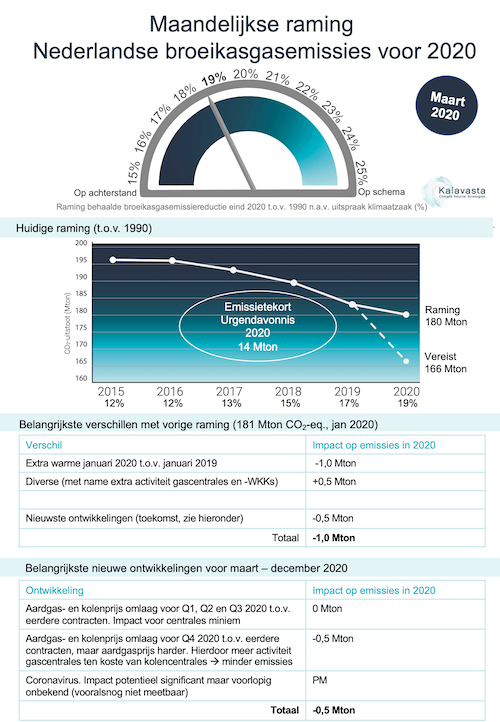Emissions monitor 2020 (2020)


Following the Urgenda court ruling the Netherlands has to reduce its greenhouse gas (GHG) emissions by at least 25% by the end of year 2020 with respect to 1990 levels. In the year 2018, at the time of writing the last year of which we have full emission statistics, GHG emissions were almost 15% lower than in 1990. There is therefore still a large 10% gap between the last official measurements in 2018 and the ambitions for 2020. Kalavasta estimated in early 2020 an emission reduction of 19% in 2020, which meant the Netherlands was not on track to achieve the required reduction of 25%. This January 2020 estimate did not yet include the impact of the COVID-19 virus on GHG emissions. In the “Klimaat en Energieverkenning 2019” PBL estimated an emission reduction of 23%, with a range of 19-26%. This estimate was revised in December 2019 with a new value of 20 to 21%. The next update to the PBL 2020 emission figures in not expected before October 2020 and the first CBS emission figures on 2020 are expected in May 2021. Hence there is limited visibility for policy makers on whether the measures taken are actually having the desired effect on the national emissions.
Urgenda requested Kalavasta to set up a methodology to estimate greenhouse gas emissions on a monthly basis and track the progress towards the 2020 emission reduction target, taking into account the measures that the government takes to reduce GHG emissions. The up-to-date information will assist policymakers in assessing the effect that implemented measures are having and help decide on additional measures to meet the target. As the time left to meet the 25% emission reduction by the end of 2020 target is limited, information on the effects of policies with a higher granularity with regards to time allows for vital feedback. As time passes, more data becomes available. Consequently, the uncertainty of the estimates will decrease as the year progresses, and the estimates converge to the actual emissions.
The emissions included in the monitor are the emissions that count towards a country’s greenhouse gas emissions under the UNFCCC. This includes emissions of the built environment, agriculture, mobility, industry, and electricity generation. Emissions from international shipping and international aviation are not included in national emissions. We use CBS data for natural gas, coal, and oil consumption published that is lagging two months. This data is then adjusted by accounting for expected growth in different sectors. The natural gas consumption by the built environment is adjusted for the monthly mean temperature. Data on electricity production is derived from Entso-E platform, which publishes data with a delay of only some days. Oil consumption by the mobility sector is also adjusted to account for the blending of biofuels. In the estimates we took into account measures taken to reduce greenhouse gas emissions as well as societal events affecting them. Current work focusses especially on the effect the Corona crisis is having on business activity and thereby emissions as a consequence of (partial) lockdowns around the globe.
We have set up the method and documentation in a manner that would allow another party to take over the monitoring. PBL is considering adopting this methodology for short term forecasting for the KEV 2020. Urgenda has published the monitor of March 2020. However, due to the COVID-19 pandemic emissions forecasts became less accurate and therefore the emissions monitor project was halted.
We are currently developing a new version of the emissions monitor, which is based on the same methodology but focuses only on near real-time GHG emissions. The new emissions monitor will be built as a webtool which is automatically updated with the latest emissions data.